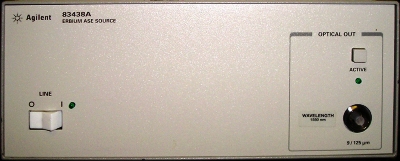
|
|
The Agilent 83438A Erbium ASE Source provides incoherent light for characterizing fiber-optic components. Its output is centered at approximately 1550 nm. Because it has a relatively high-power spectral density, you can probe devices with medium or high insertion loss. Its single-mode output originates from the amplified spontaneous emission (ASE) of an Erbium doped fiber amplifier. The power spectral density of the output is up to one hundred times (20 dB) greater than that of edge emitting LEDs (for example, the Agilent 83437A Broadband Light Source) and up to 100,000 times (50 dB) greater than white-light tungsten lamp sources. An internal optical isolator protects the Agilent 83438A from back reflections from the device under test. This greatly improves the power stability of the Agilent 83438A. Specifications. Total output power: +8.1 dBm maximum (6.5 mW), +5.5 dBm minimum (3.5 mW) . Power stability: < ±0.02 dB (15 minutes), < ±0.05 dB (6 hours). Compatible fiber: 9/125 µm, single mode. Spectral density: > –13 dBm [1 nm] (> 50 µW/nm) @ 1530, 1550, 1560 nm. Output return loss: > 30 dB (characteristic). Degree of polarization: < 5%, standard (characteristic). Modulation: Digital (TTL compatible), DC to 300 Hz (characteristic). Options. 009, Built-in polarizer. 011, Diamond HMS-10 fiber-optic input connector interface. 013, DIN 47256 fiber-optic input connector interface. 014, ST fiber-optic input connector interface. 017, SC fiber-optic input connector interface. 022, Angled contact fiber-optic output interface.
|